Assessment of Unintentional Islanding Operations in Distribution Networks with Large Induction Motors
Abstract
1. Introduction
2. Test System Description
3. Field Measurements
- Figure 2 depicts some recordings measured at the source side of PCC1. The two plots show frequency, voltage and current variations during a period that covers pre-fault, during-fault, and post-fault scenarios, including the post-reclosing period. The beginning of the full event is depicted in Figure 2a; the upper arrows indicate the three parts of the transient process. One can observe voltage and current variations due to CB operation: The measured currents correspond to those flowing through feeder B; the frequency is that of the transmission system and remains constant; voltages are affected by substation grounding, and they exhibit both sags and swells. Take into consideration that this can also affect the unfaulted feeder loads. Figure 2b plots the transient response caused by the reclosing operation: The current due to the re-energization, the effect of the current drawn due to the IM reacceleration, and the effect of the out-of-phase reconnection are observable.
- Figure 3 depicts the measurements recorded at the MV side of the transformer at the load-side of PCC2 during the same period that Figure 2. After CB operation, the IM continues connected to the feeder, which does not longer supply active power. Consequently, the frequency in this part of the system steadily decreases until the reclosing instant. Figure 3b also shows that, according to the waveforms measured, after CB reclosing the IM reaccelerates until it recovers its rate speed, although, initially, the frequency (and the IM speed) decreases even more as a consequence of the reclosing transient; see Section 4. Take into account that frequency and voltage mismatches between the two CB terminals at the reclosing time will cause a transient torque that could seriously affect the machine.
4. System Components Modeling
4.1. Introduction to Modeling Guidelines
- The saturation effect is considered in transformers.
- Transmission line impedance, for each particular section, is assumed to be equal for the three phases.
- IM is modelled as saturable because of the stator current increment that follows CB opening.
- Typical IEC-IEEE curves are considered for protective devices.
4.2. Transmission System
4.3. Transformers
4.4. Protective Devices
4.5. Induction Motors
4.6. Loads
4.7. System Model
5. Islanding Analysis
5.1. Overview
5.2. Dynamic Model Analysis during Islanding
6. Model Validation
6.1. Event 1
6.2. Event 2
6.3. Event 3
6.4. Discussion
7. Conclusions
Author Contributions
Funding
Acknowledgments
Conflicts of Interest
Appendix A
| Internal Parameters | Values | Rated Parameters | Values |
|---|---|---|---|
| Ls | 0.0078 H | P | 160 kW |
| Lr | 0.0078 H | 𝓅 | 1 |
| Rr | 0.0077 Ω | f | 50 Hz |
| Rs | 0.0137 Ω | V | 400 V |
| Lm | 0.0076 H | J | 2.9 kgm2 |
| Transformers | |||||||
| Transformer Type | Vp/Vs (kV) | S (MVA) | ε (%) | Lm/Rm (H/kΩ) | |||
| Substation transformer | TR1 | 120/25 kV | 10 | 10.4 | 78; 313 | ||
| Distribution transformers | TR2 | 25/0.4 kV | 1 | 6 | 180; 370 | ||
| TR3 | 25/0.4 kV | 0.63 | 5.1 | 350; 480 | |||
| TR4 | 25/0.4 kV | 0.4 | 4.3 | 404; 694 | |||
| TR5 | 25/0.4 kV | 0.25 | 4.1 | 811; 1666 | |||
| Distribution Lines | |||||||
| Lines | Nodes | Length (km) | Parameters:Z1/Z0 (Ω/km); C0 (μF/km) | Loadability (A) | |||
| L1 | 2–4 | 5 | 0.306 + j0.405/0.38 + j1.62 | 300 | |||
| L2 | 4–3 | 3.3 | 1.07 + j0.441/1.3 + j1.76, | 120 | |||
| L3 | 4–6 | 4.3 | 0.306 + j0.405/0.38 + j1.62 | 300 | |||
| L4 | 6–5 | 4 | 1.07 + j0.441/1.3 + j1.76 | 120 | |||
| L5 | 6–7 | 2.5 | 0.306 + j0.405/0.38 + j1.62 | 300 | |||
| L6 | 7–8 | 2 | 0.306 + j0.405/0.38 + j1.62 | 300 | |||
| L7 | 8–9 | 7 | 0.687 + j0.416/0.8 + j1.66 | 200 | |||
| L8 | 2–10 | 3.8 | 0.127 + j0.114/0.17 + j0.45; 0.229 | 389 | |||
| L9 | 10–11 | 4.43 | 0.208 + j0.123/0.278 + j0.492; 0.192 | 320 | |||
| L10 | 11–12 | 4 | 0.687 + j0.416/0.8 + j1.66 | 200 | |||
| L11 | 12–13 | 3.3 | 0.687 + j0.416/0.8 + j1.66 | 200 | |||
| L12 | 1–2 | 0.28 | 0.306 + j0.405/0.38 + j1.62 | 300 | |||
Appendix B
| Load Node | Rated Voltage (V) | Rated P/Q (kW/kVAr) | Load Model * |
|---|---|---|---|
| Node 15 | 400 | 30/4 | Constant power |
| Node 16 | 400 | 100/20 | Constant impedance |
| Node 17 | 400 | 300/45 | Constant impedance |
| Node 18 | 400 | 600/−157 | Induction motors |
| Node 19 | 400 | 100/10 | Constant impedance |
| Node 20 | 400 | 30/4 | Constant current |
| Node 21 | 400 | 25/10 | Constant impedance |
| Node 22 | 400 | 200/80 | Constant impedance |
| Node 23 | 400 | 40/18 | Constant impedance |
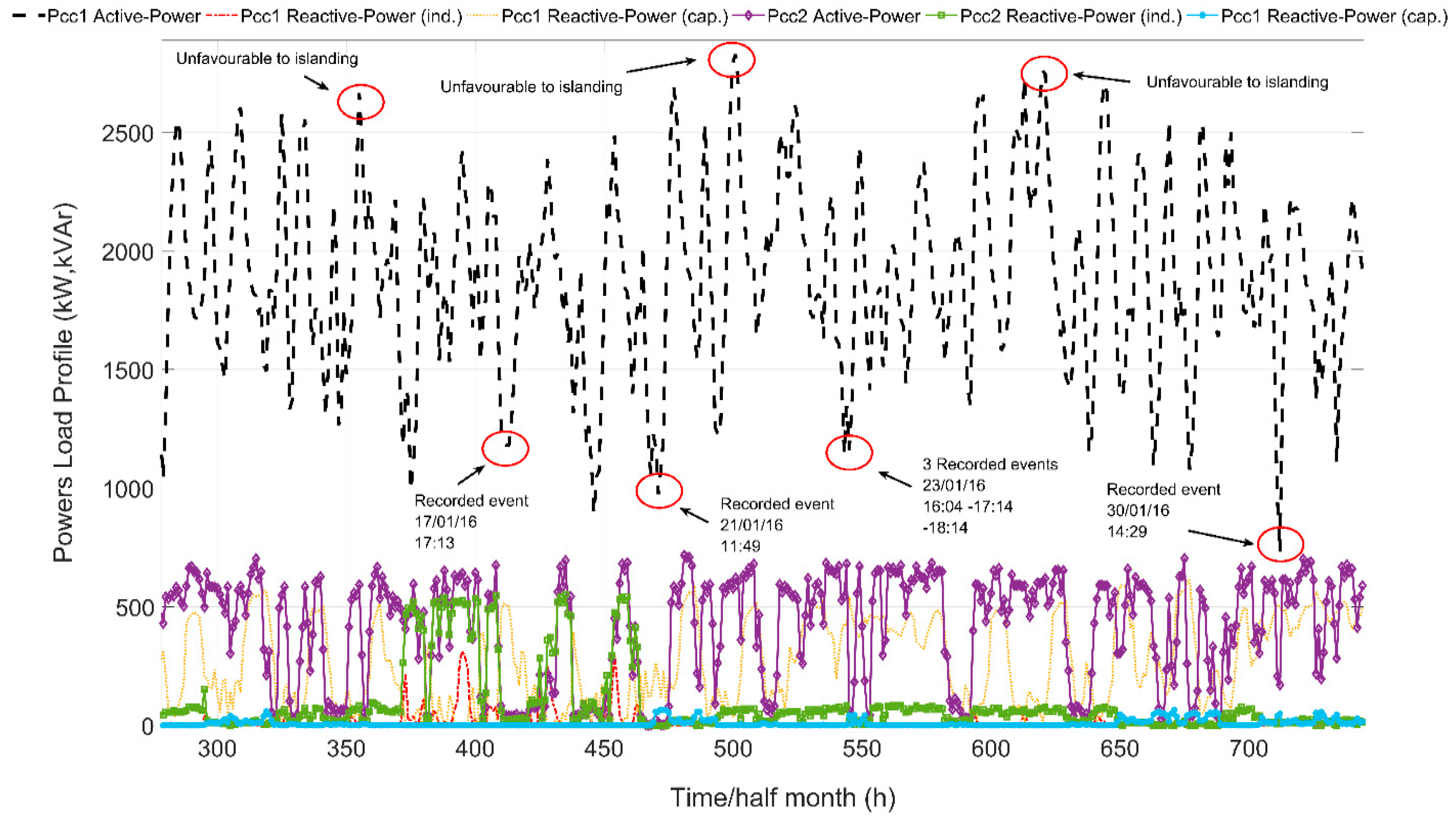
References
- Bignucolo, F.; Cerretti, A.; Coppo, M.; Savio, A.; Turri, R. Impact of distributed generation grid code requirements on islanding detection in LV networks. Energies 2017, 10, 156. [Google Scholar] [CrossRef]
- Song, H.; Wu, J.; Wu, K. A wide-area measurement systems-based adaptive strategy for controlled islanding in bulk power systems. Energies 2014, 7, 2631–2657. [Google Scholar] [CrossRef]
- IEEE Standards Coordinating Committee 21. IEEE Application Guide for IEEE Std 1547TM, IEEE Standard for Interconnecting Distributed Resources with Electric Power Systems; IEEE Press: Piscataway, NJ, USA, 2009. [Google Scholar]
- Khodaparastan, M.; Vahedi, H.; Khazaeli, F.; Oraee, H. A Novel hybrid islanding detection method for inverter-based DGs using SFS and ROCOF. IEEE Trans. Power Deliv. 2017, 9, 6448–6460. [Google Scholar]
- di Fazio, A.R.; Russo, M.; Valeri, S. A new protection system for islanding detection in LV distribution systems. Energies 2015, 8, 3775–3793. [Google Scholar] [CrossRef]
- Chen, Y.; Xu, Z.; Østergaard, J. Control mechanism and security region for intentional islanding transition. In Proceedings of the 2009 IEEE Power Energy Society Genenerl Meeting, PES ’09, Calgari, AB, Canada, 23–26 July 2009; pp. 1–6. [Google Scholar]
- Serrano-Fontova, A.; Casals-Torrens, P.; Bosch, R. Power quality disturbances assessment during unintentional islanding scenarios. A contribution to voltage sag studies. Energies 2019, 12, 3198. [Google Scholar] [CrossRef]
- Ambia, M.N.; Al-Durra, A. Adaptive power smoothing control in grid-connected and islanding modes of hybrid micro-grid energy management. J. Renew. Sustain. Energy 2015, 7. [Google Scholar] [CrossRef]
- Mulukutla, S.S.; Gulachenski, E.M. A Critical Survey of considerations in maintaining process continuity during voltage dips while protecting motors with reclosing and bus-transfer practices. IEEE Trans. Power Syst. 1992, 7, 1299–1305. [Google Scholar] [CrossRef]
- Pettigrew, R.D.; Powell, P.; Burnworth, J.; Haas, R.; Gil-Berlinches, J.; Waudby, P.; Mozina, C.; Pierce, A.; Beckwith, F.T.R.; et al. Motor bus transfer. IEEE Trasactions Power Deliv. 1993, 8, 1747–1758. [Google Scholar] [CrossRef]
- Beckwith, T.R.; Hartmann, W.G. Motor bus transfer: Considerations and methods. IEEE Trans. Ind. Appl. 2006, 42, 602–611. [Google Scholar] [CrossRef]
- Yalla, M.V.V.S. esign of a high-speed motor bus transfer system. IEEE Trans. Ind. Appl. 2010, 46, 612–619. [Google Scholar] [CrossRef]
- Muralimanohar, P.K.; Haas, D.; McClanahan, J.R.; Jagaduri, R.T.; Singletary, S. Implementation of a Microprocessor-Based Motor Bus Transfer Scheme. IEEE Trans. Ind. Appl. 2018, 54, 4001–4008. [Google Scholar] [CrossRef]
- Martinez, J.A. Power System Transients: Parameter Determination; CRC PRESS: Boca Raton, FL, USA, 2010; Volume 8. [Google Scholar]
- Martinez, J.A.; Johnson, B.; Grande-Moran, C. Parameter determination for modeling system transients—Part IV: Rotating Machines. IEEE Trans. Power Deliv. 2005, 20, 2063–2072. [Google Scholar] [CrossRef]
- Ormazabal Protection and Automation, EkorRPS-Multifunctional Protection. Available online: https://www.ormazabal.com/es/tu-negocio/productos/ekorrps (accessed on 9 January 2020).
- Martinez, J.A.; Gustavsen, B.; Durbak, D. Parameter determination for modeling system transients—Part I: Overhead lines. IEEE Trans. Power Deliv. 2005, 20, 2038–2044. [Google Scholar] [CrossRef]
- Papagiannis, G.K.; Papadopoulos, T.A.; Chrysochos, A.I. Rigorous calculation method for resonance frequencies in transmission line responses. IET Gener. Transm. Distrib. 2015, 9, 767–778. [Google Scholar]
- Papadopoulos, T.A.; Chrysochos, A.I.; Papagiannis, G.K. Analytical study of the frequency-dependent earth conduction effects on underground power cables. IET Gener. Transm. Distrib. 2013, 7, 276–287. [Google Scholar] [CrossRef]
- Papadopoulos, T.A.; Tsiamitros, D.A.; Papagiannis, G.K. Impedances and admittances of underground cables for the homogeneous earth case. IEEE Trans. Power Deliv. 2010, 25, 961–969. [Google Scholar] [CrossRef]
- IEEE. IEEE Standard for General Requirements for Liquid-Immersed Distribution, Power, and Regulating Transformers; IEEE Press: Piscataway, NJ, USA, 2016. [Google Scholar]
- Neves, W.L.A.; Dommel, H.W. Saturation Curves of Delta-Connected Transformers from Measurements. IEEE Trans. Power Deliv. 1995, 10, 1432–1437. [Google Scholar] [CrossRef]
- Martinez, J.A.; Walling, R.; Mork, B.A.; Martin-Arnedo, J.; Durbak, D. Parameter determination for modeling system transients—Part III: Transformers. IEEE Trans. Power Deliv. 2005, 20, 2051–2062. [Google Scholar] [CrossRef]
- de León, F.; Martinez, J.A. Dual three-winding transformer equivalent circuit matching leakage measurements. IEEE Trans. Power Deliv. 2009, 24, 160–168. [Google Scholar] [CrossRef]
- Rezaei-Zare, A. Enhanced transformer model for low- And mid-frequency transients—Part II: Validation and simulation results. IEEE Trans. Power Deliv. 2015, 30, 316–325. [Google Scholar] [CrossRef]
- Abdulsalam, S.G.; Xu, W.; Neves, W.L.A.; Liu, X. Estimation of transformer saturation characteristics from inrush current waveforms. IEEE Trans. Power Deliv. 2006, 21, 170–177. [Google Scholar] [CrossRef]
- Papaspiliotopoulos, V.A.; Korres, G.N.; Kleftakis, V.A.; Hatziargyriou, N.D. Hardware-In-the-Loop Design and Optimal Setting of Adaptive Protection Schemes for Distribution Systems with Distributed Generation. IEEE Trans. Power Deliv. 2017, 32, 393–400. [Google Scholar]
- Jia, K.; Wei, H.; Bi, T.; Thomas, D.W.P.; Sumner, M. An Islanding Detection Method for Multi-DG Systems Based on High-Frequency Impedance Estimation. IEEE Trans. Sustain. Energy 2017, 8, 1. [Google Scholar] [CrossRef]
- Martinez, J.A.; Mahseredjian, J.; Khodabakhchian, B. Parameter Determination for Modeling System Transients—Part VI: Circuit Breakers. IEEE Trans. Power Deliv. 2005, 20, 2079–2085. [Google Scholar] [CrossRef]
- Corcoles, F.; Pedra, J.; Salichs, M.; Sainz, L. Analysis of the induction machine parameter identification. IEEE Trans. Energy Convers. 2002, 17, 183–190. [Google Scholar] [CrossRef]
- Schneider, K.P.; Fuller, J.C.; Chassin, D.P. Multi-state load models for distribution system analysis. IEEE Trans. Power Syst. 2011, 26, 2425–2433. [Google Scholar] [CrossRef]
- Alexiadis, M.C.; Papagiannis, G.K.; Panapakidis, I.P. Enhancing the clustering process in the category model load profiling. IET Gener. Transm. Distrib. 2015, 9, 655–665. [Google Scholar]
- Hill, D.J. Nonlinear dynamic load models with recovery for voltage stability studies. IEEE Trans. Power Syst. 1993, 8, 166–176. [Google Scholar] [CrossRef]
- Li, H.; Chen, Q.; Fu, C.; Yu, Z.; Shi, D.; Wang, Z. Bayesian Estimation on Load Model Coefficients of ZIP and Induction Motor Model. Energies 2019, 12, 547. [Google Scholar] [CrossRef]
- IEEE Task Force on Load Representation for Dynamic Performance. Load representation for dynamic performance analysis (of power systems). IEEE Trans. Power Syst. 1993, 8, 472–482. [Google Scholar] [CrossRef]
- Zhang, Z.; Yang, H.; Yin, X.; Han, J.; Wang, Y.; Chen, G. A load-shedding model based on sensitivity analysis in on-line power system operation risk assessment. Energies 2018, 11, 727. [Google Scholar] [CrossRef]
- Farrokhabadi, M.; Cañizares, C.A.; Bhattacharya, K. Frequency control in isolated/islanded microgrids through voltage regulation. IEEE Trans. Smart Grid 2017, 8, 1185–1194. [Google Scholar] [CrossRef]
- The Mathworks Inc. MATLAB 2015-MathWorks. 2016. Available online: www.mathworks.com/products/matlab (accessed on 9 January 2020).
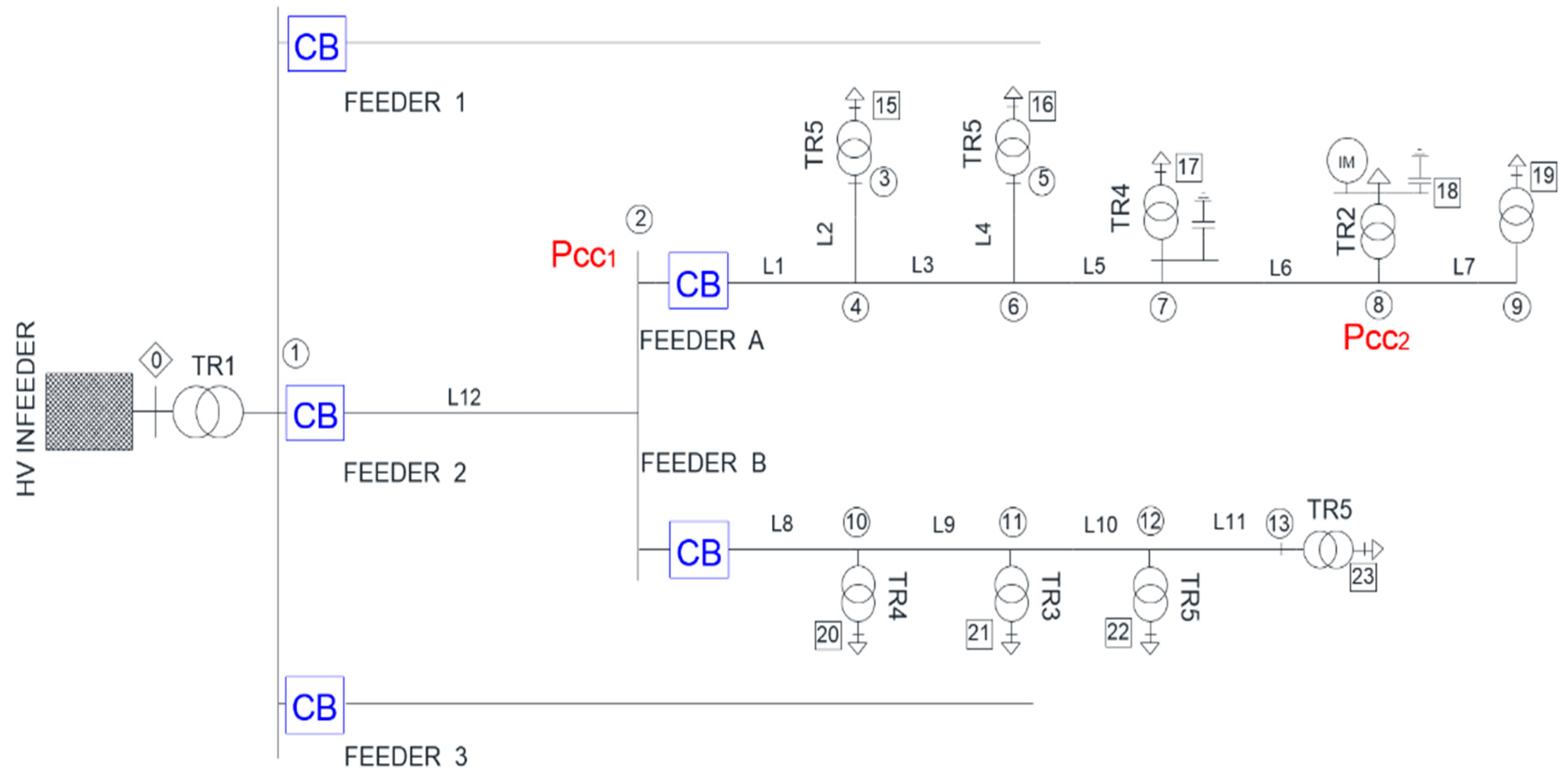
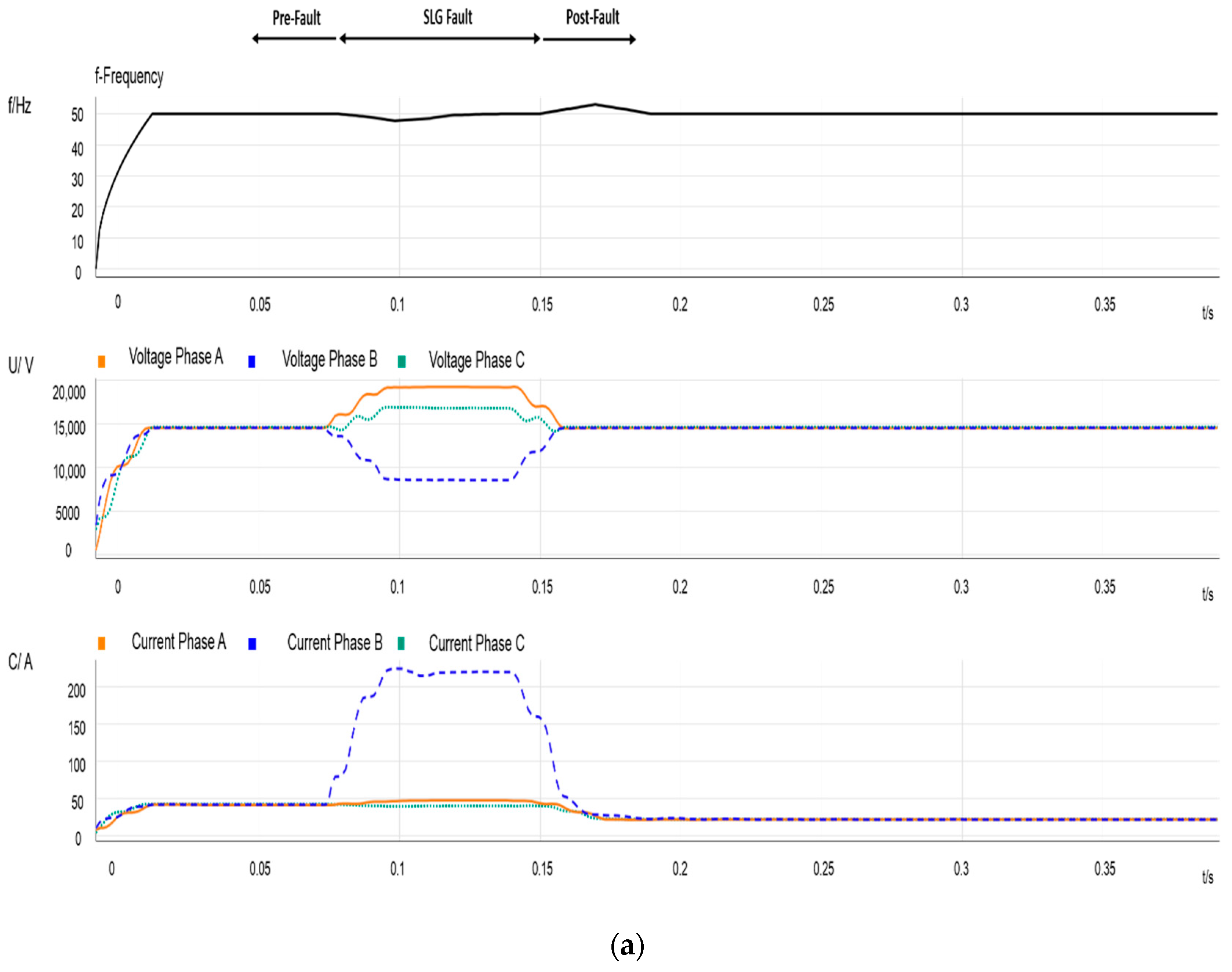
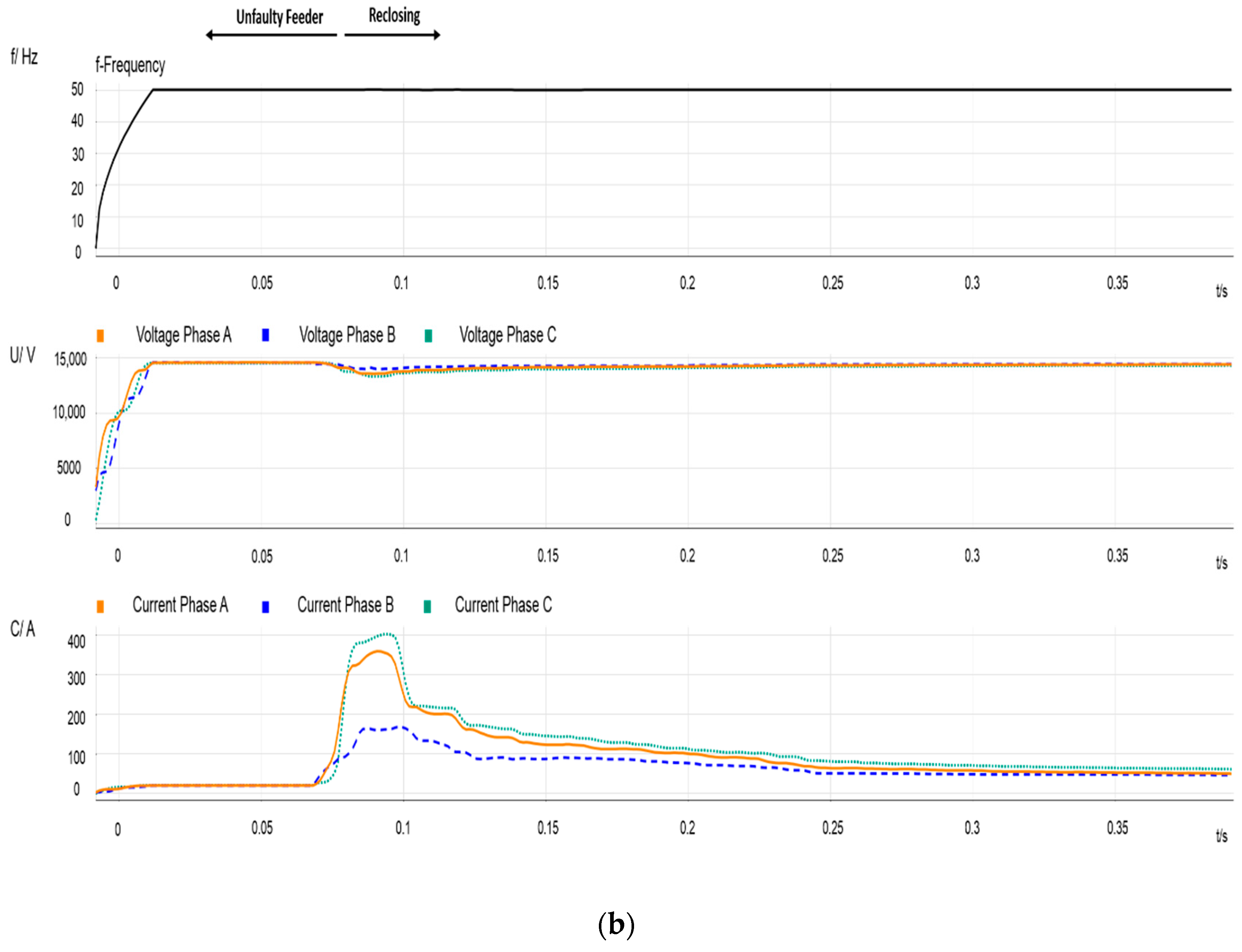


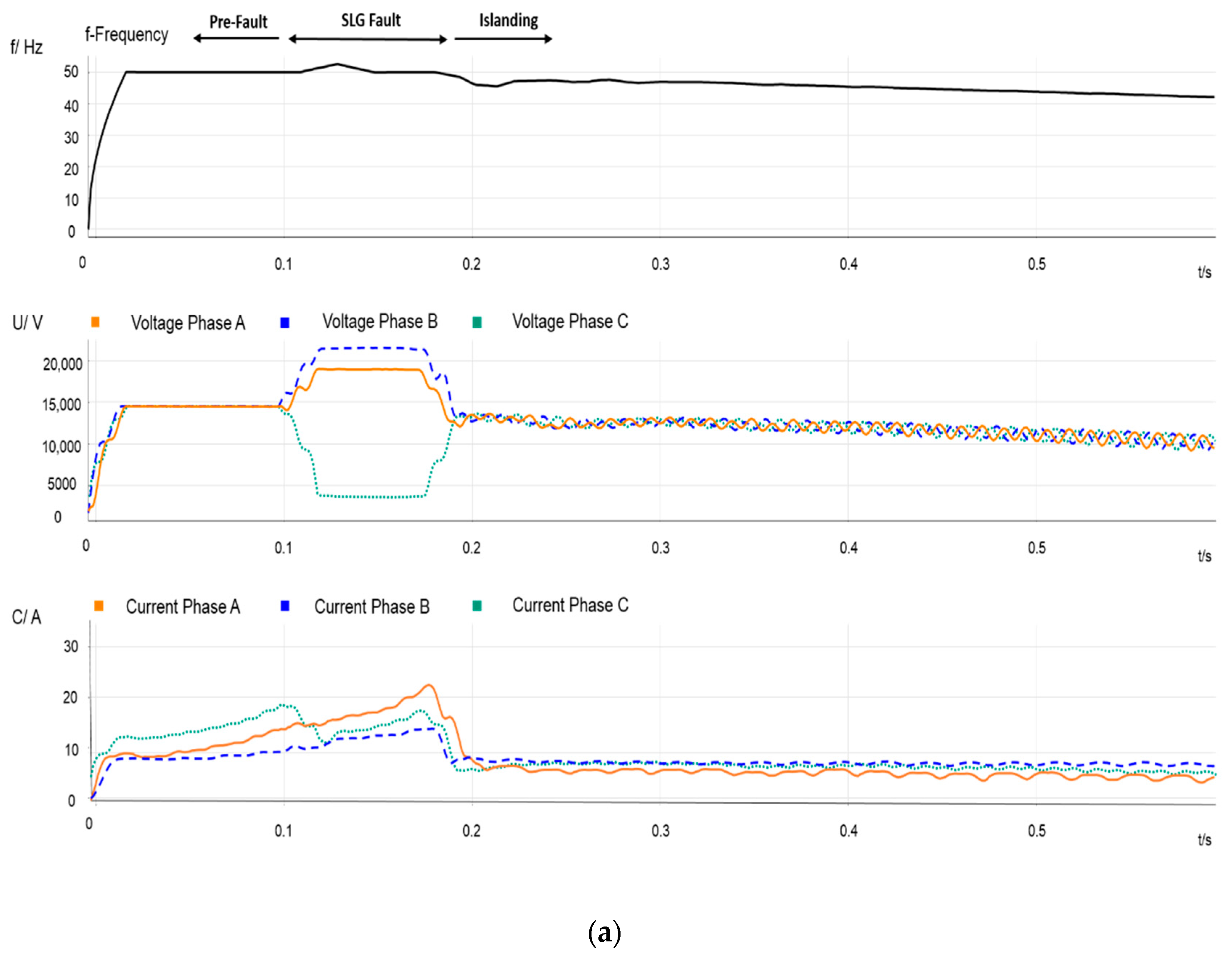
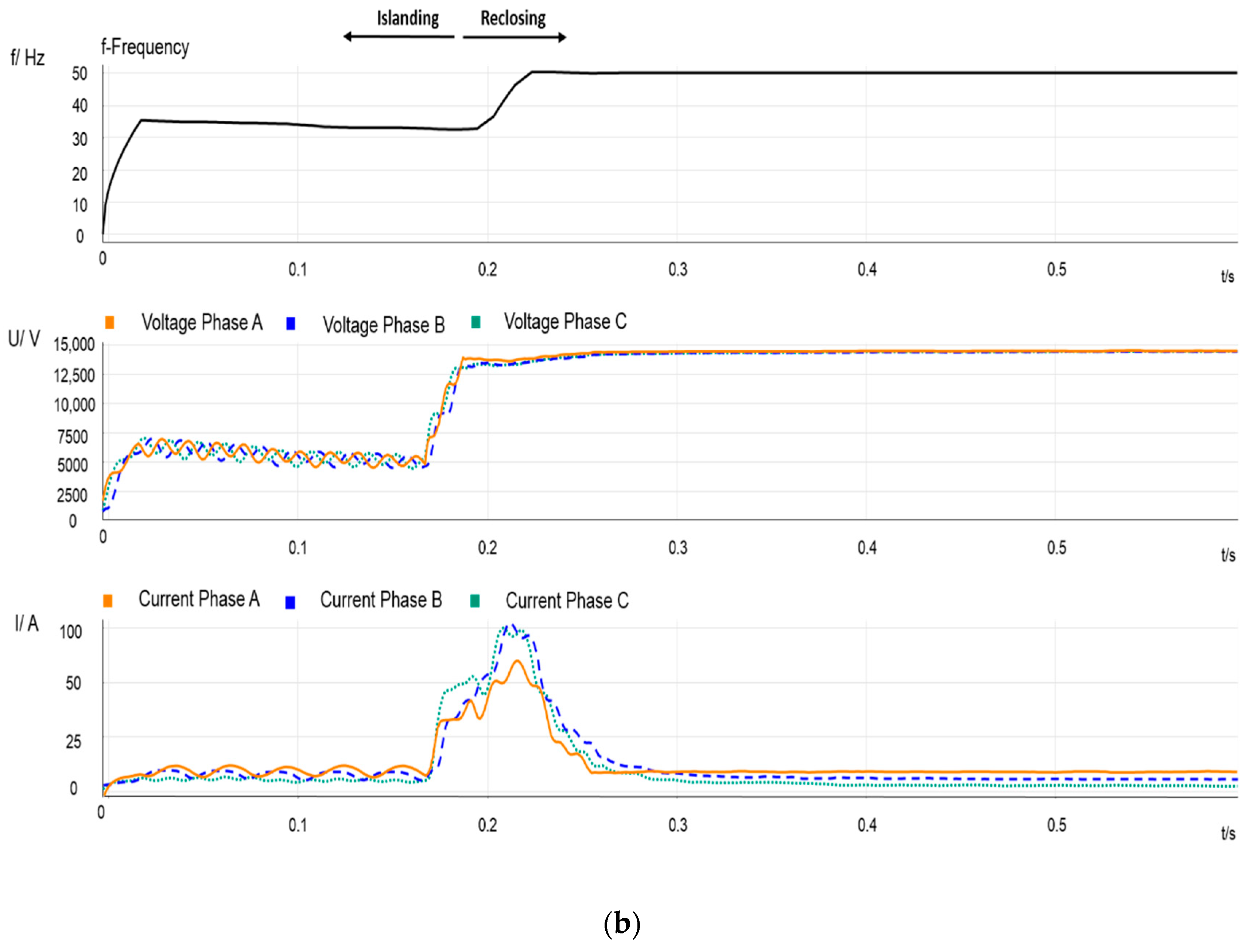


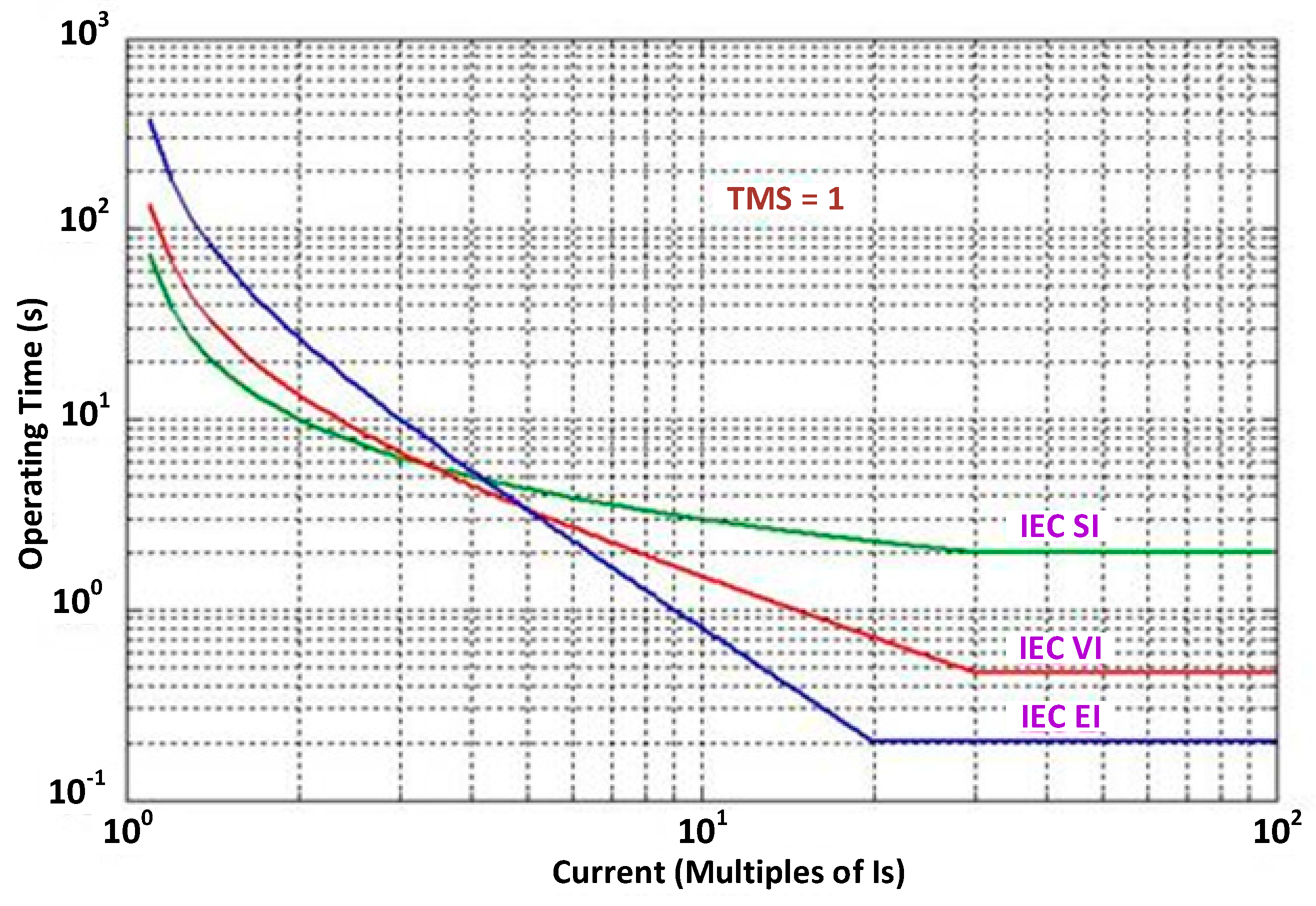

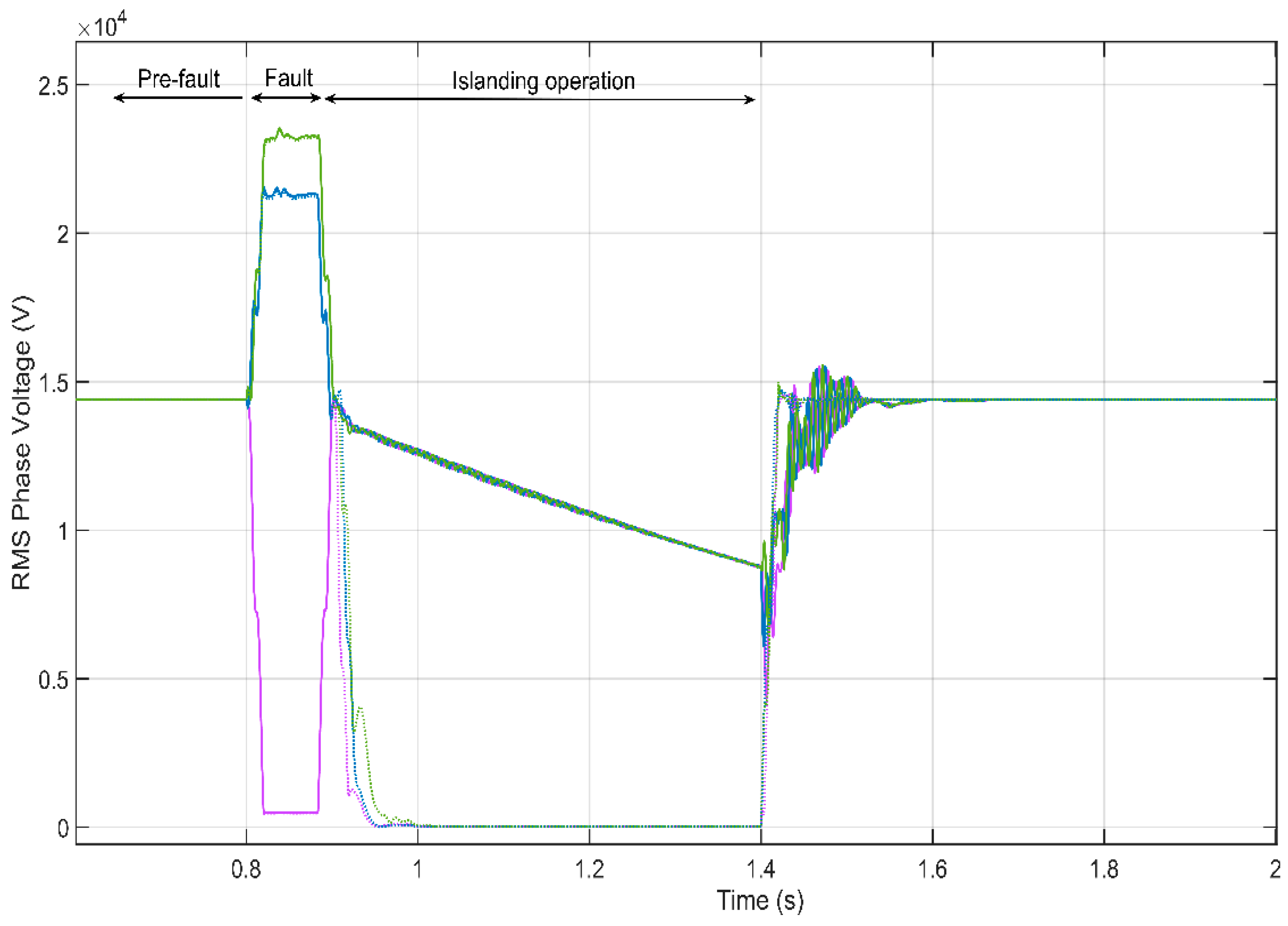

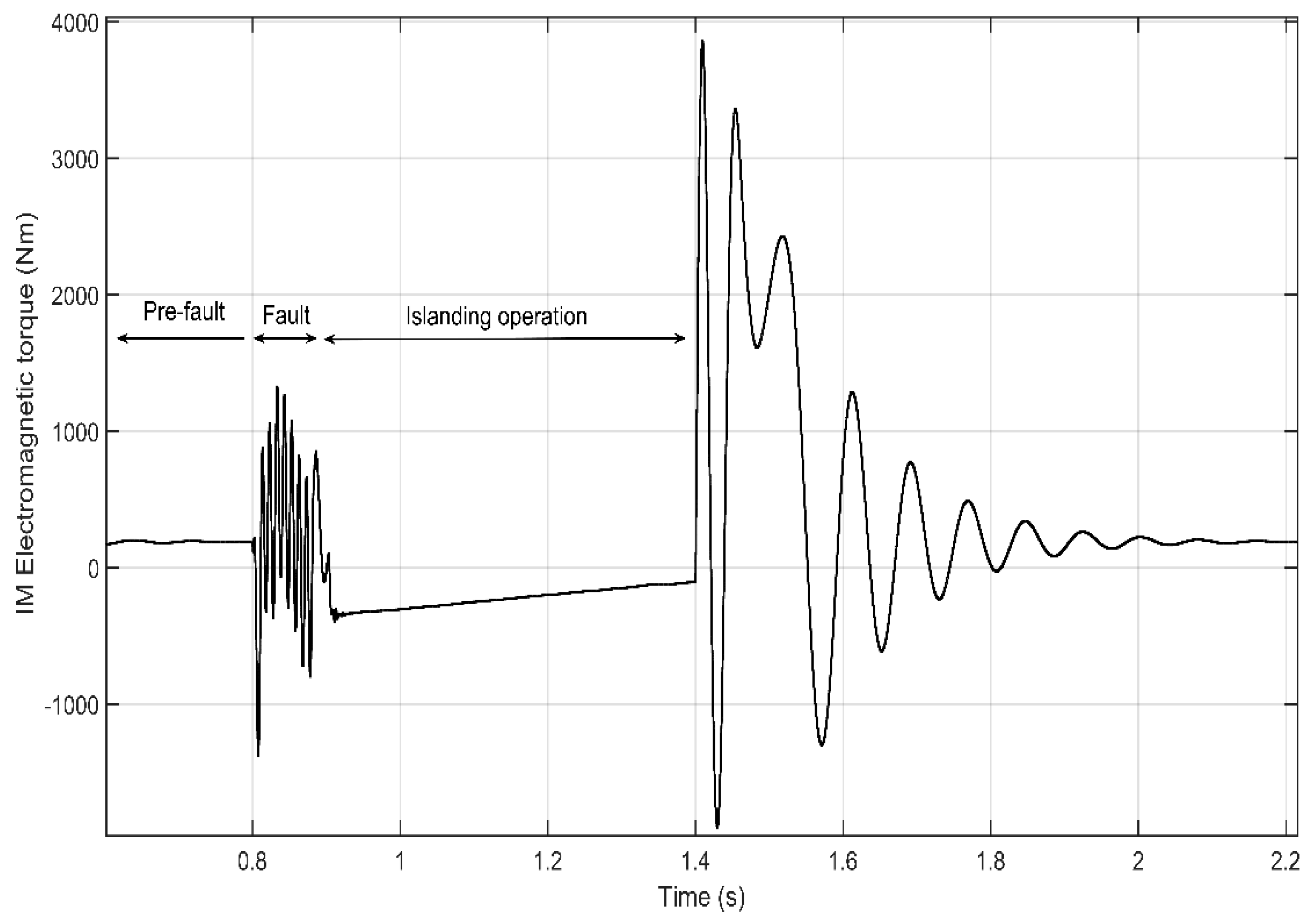
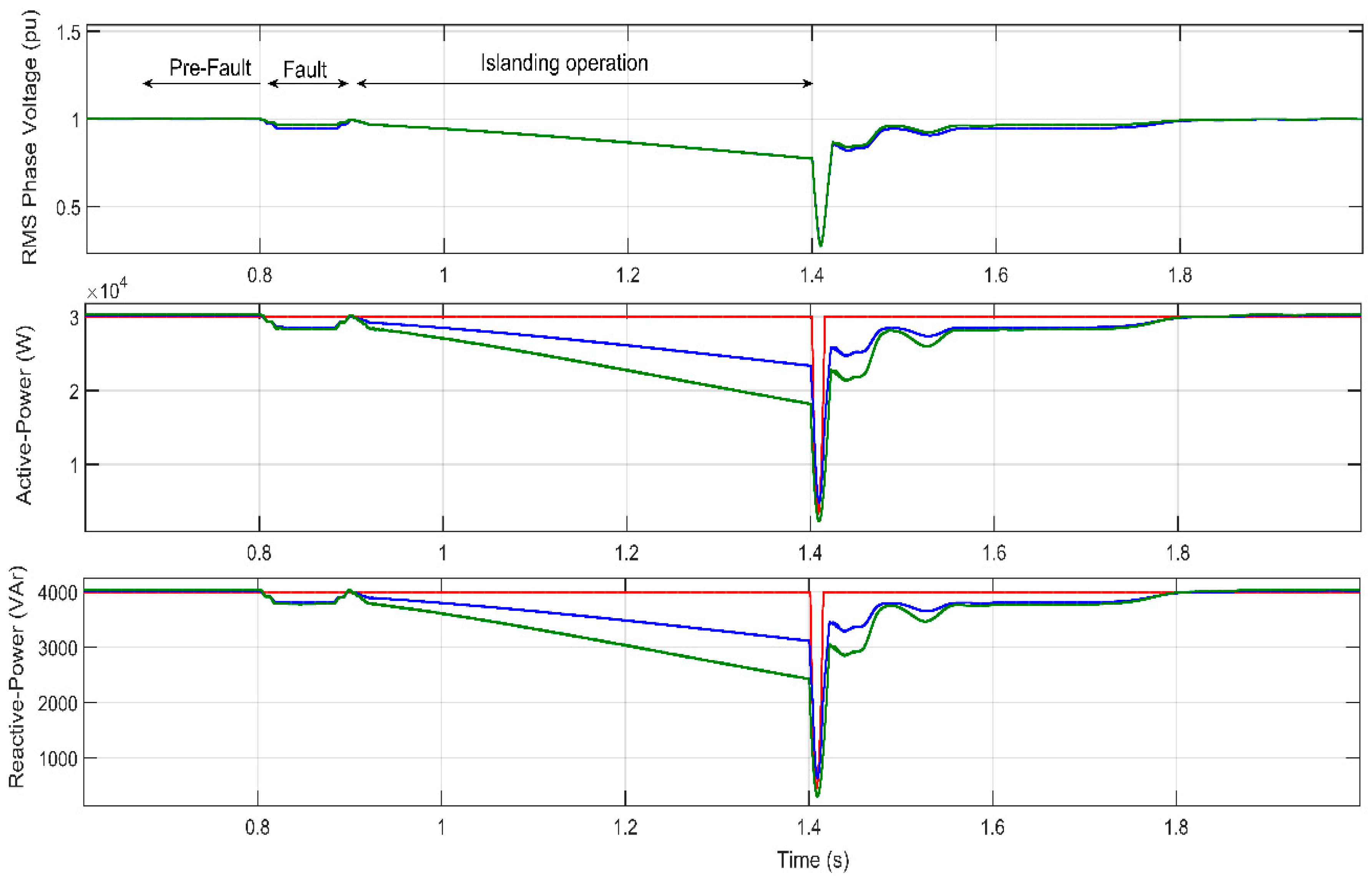
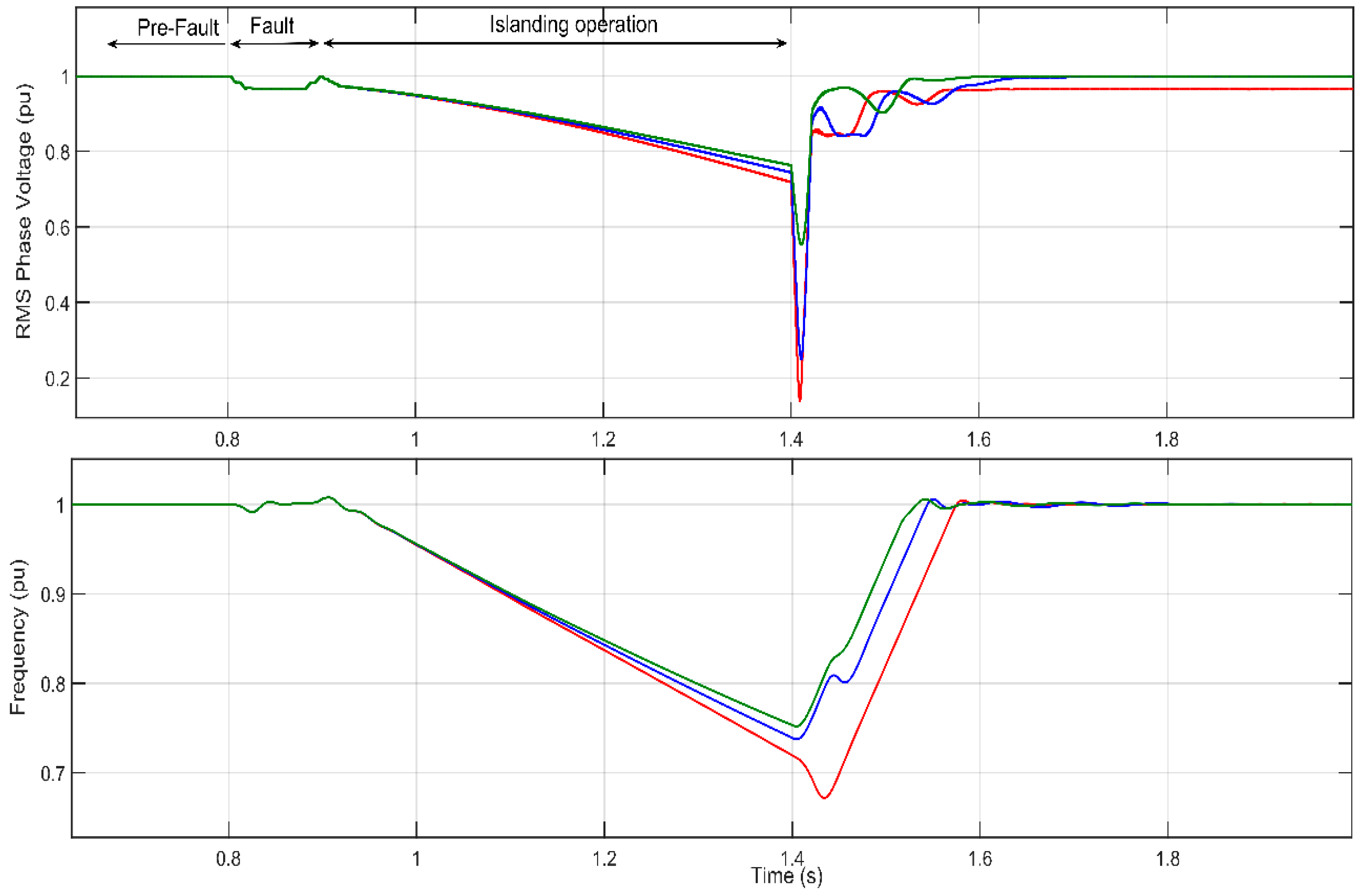
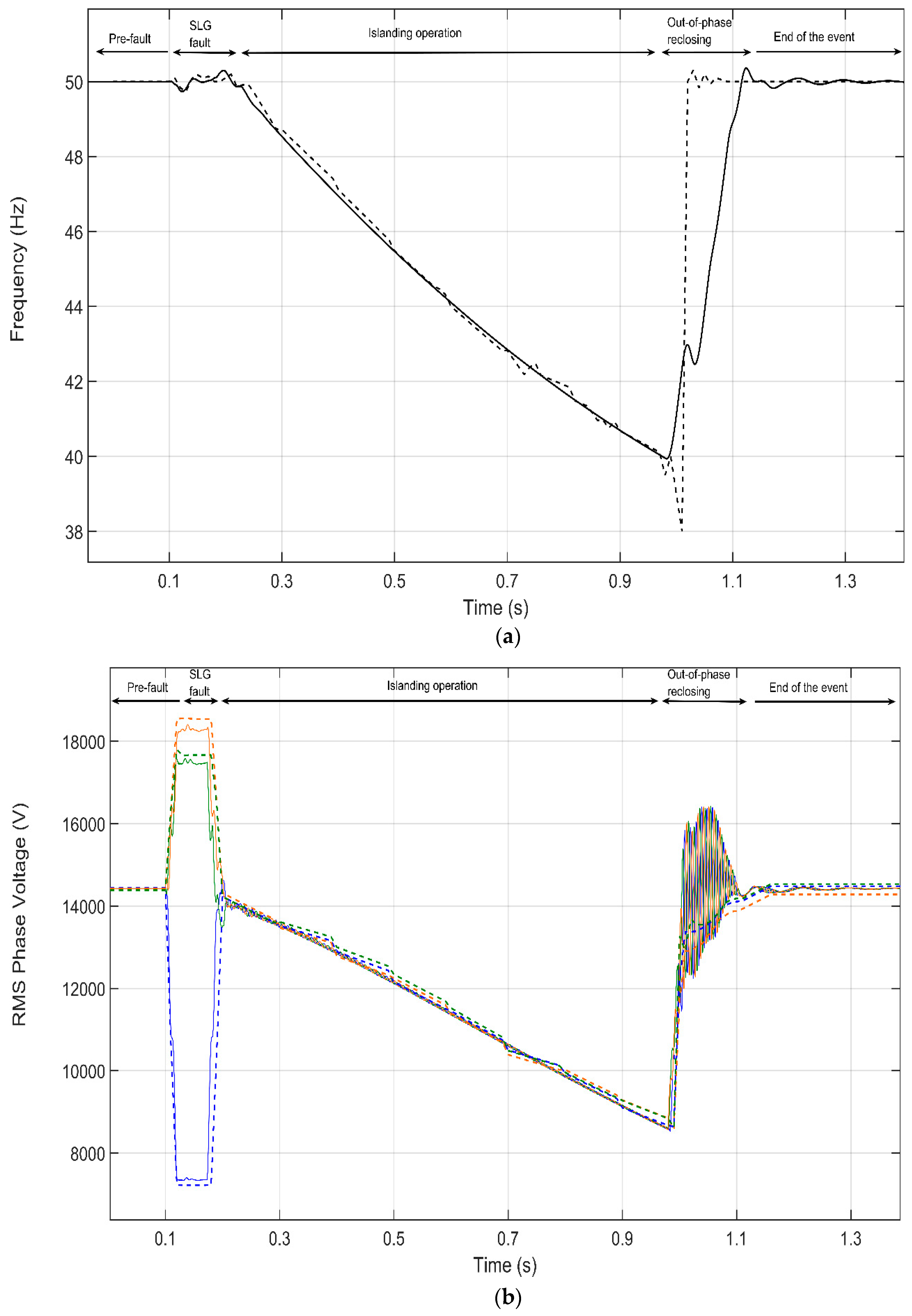
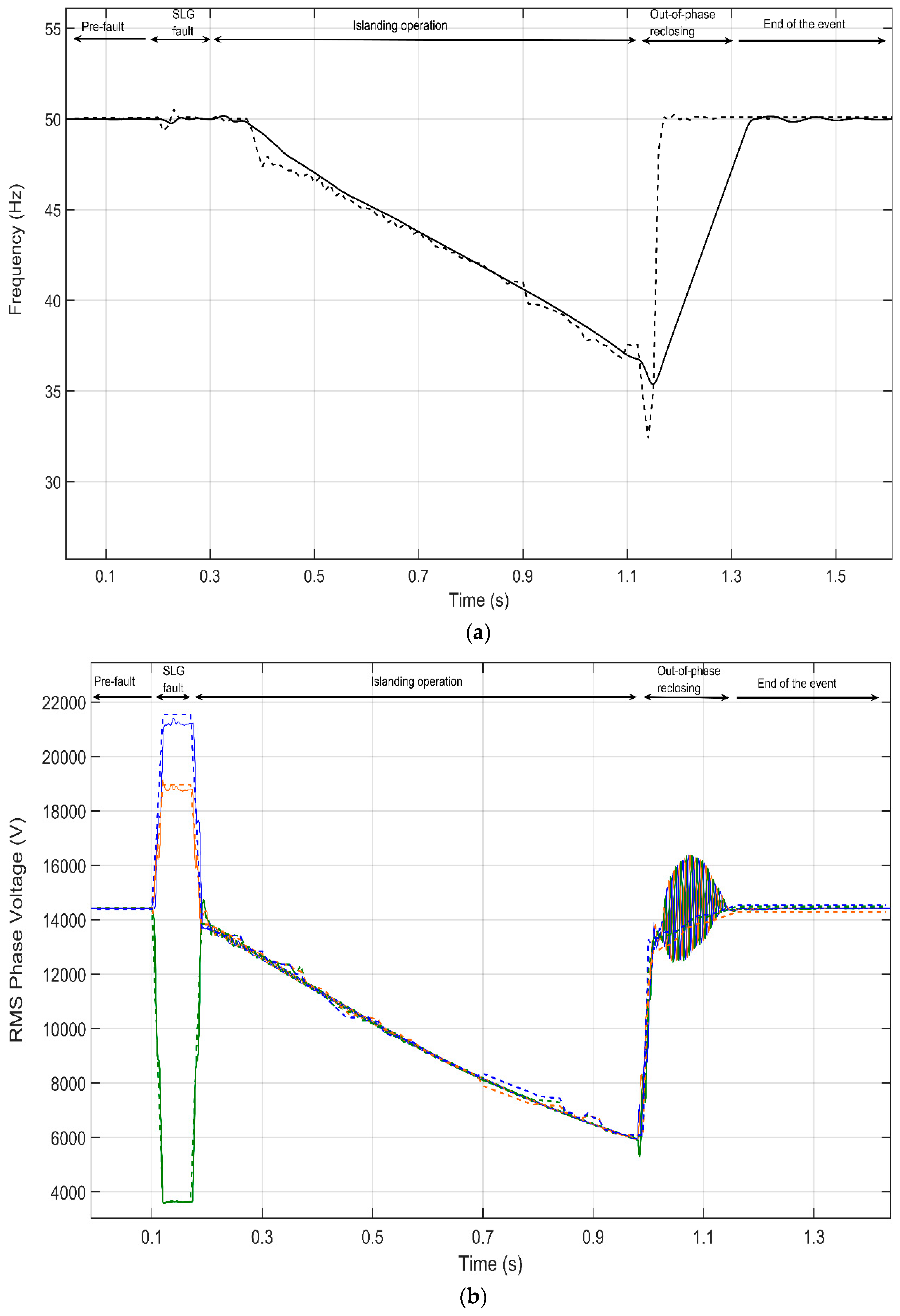
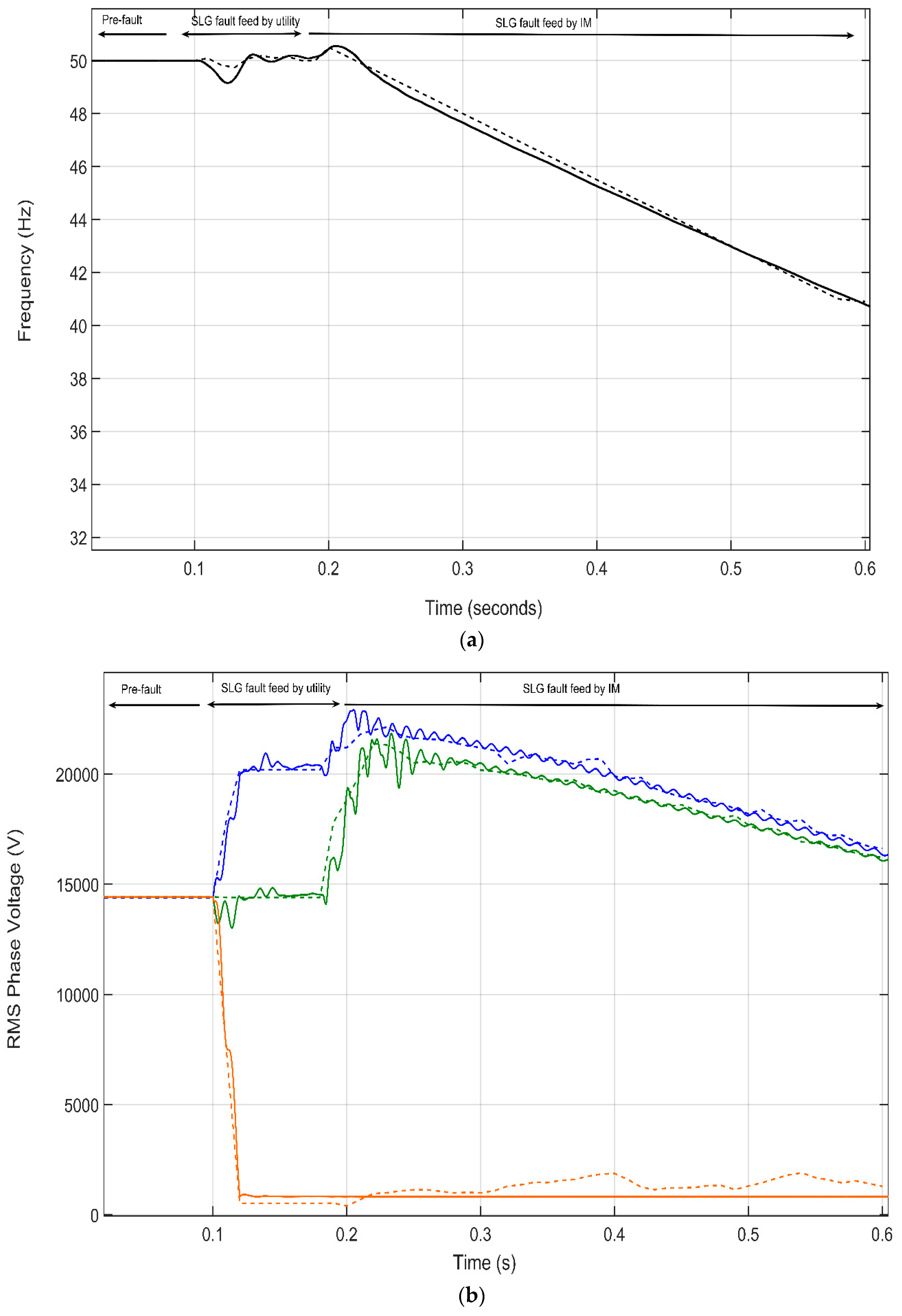

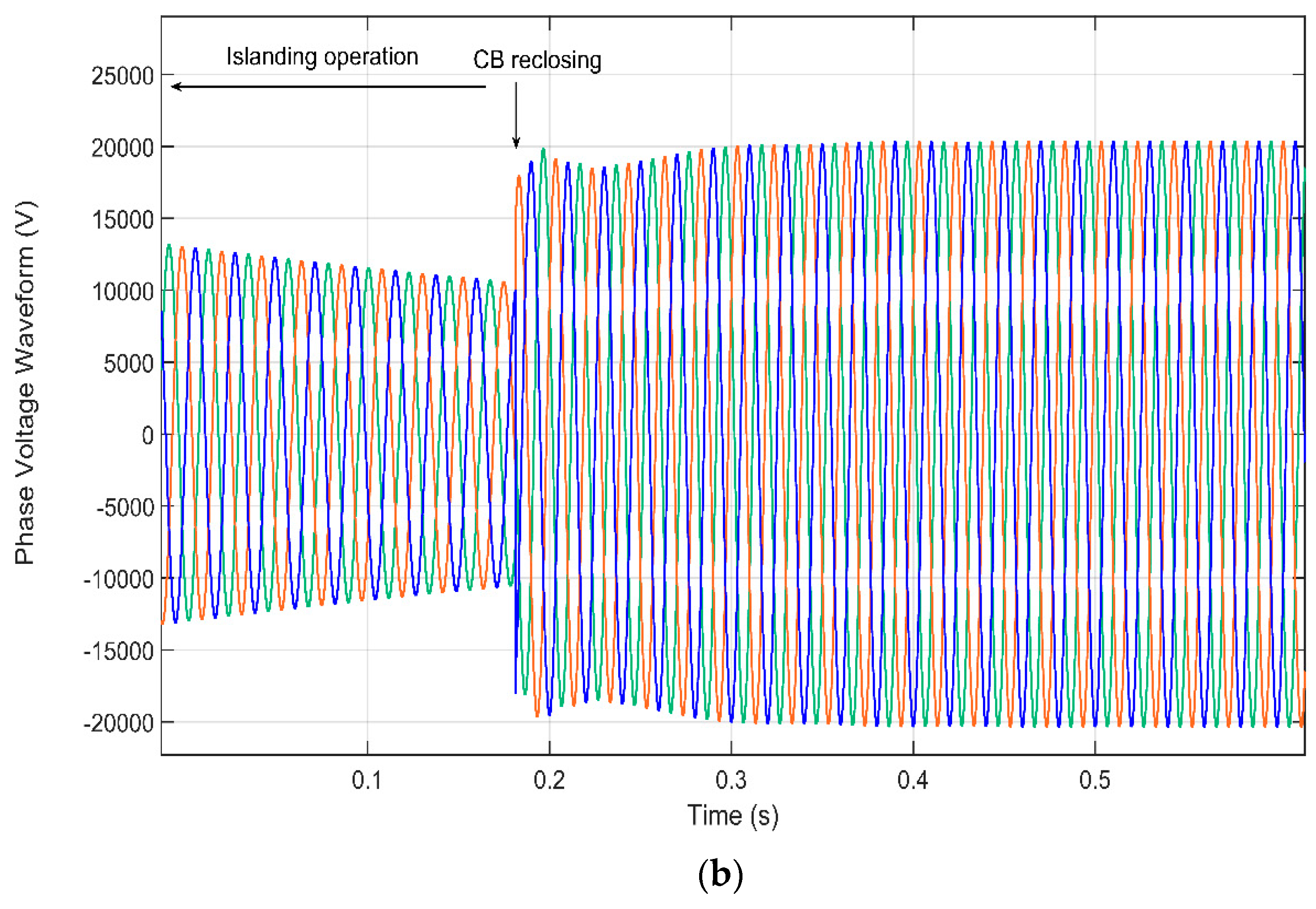
| Event | Beginning | Ending | Fault Type | Fault Current (A) | Fault Location | tcl (ms) | P (MW) | Q (MVAr) | V (kV) |
|---|---|---|---|---|---|---|---|---|---|
| 1 | 17:01:09.776 | 17:01:10.636 | SLG | 218 | Node 8 | 90 | 0.52 | −0.03 | 8.5 |
| 2 | 06:30:41.305 | 06:30:42.679 | SLG | 367 | L3 | 80 | 1 | −0.1 | 0 |
| 3 | 04:10:35.580 | 04:10:36.880 | LLG/SLG | 707 | Node 8 | 60 | 0.8 | 0 | 0 |
| 4 | 18:14:54.263 | 18:14:55.128 | SLG | 215 | Node 8 | 88 | 0.7 | −0.1 | 6.1 |
| 5 | 17:13:58.246 | 17:13:59.096 | SLG | 350 | Node 7 | 80 | 0.65 | 0.05 | 5.45 |
| 6 | 09:52:38.440 | 09:52:39.395 | SLG | 300 | Node 7 | 70 | 0.56 | −0.05 | 3.5 |
| 7 | 11:49:04.702 | 11:49:05.456 | SLG | 367 | Line 5 | 65 | 0.87 | −0.05 | 4.7 |
| 8 | 16:04:15.667 | 16:04:16.607 | LLG/SLG | 360 | Node 7 | 60 | 1.21 | −0.1 | 2.1 |
| 9 | 14:30:03.491 | 14:30:04.441 | SLG | 264 | Line 6 | 65 | 0.77 | −0.1 | 6.1 |
| ANSI Code | k | n | t | Ithreshold (A) | Iof | ANSI Curve |
|---|---|---|---|---|---|---|
| 50 | 0.05 | 0.02 | 0.14 | 100 | 1.25 | Standard inverse |
| 50n | 0.05 | 2 | 80 | 20 | − | Extremely inverse |
© 2020 by the authors. Licensee MDPI, Basel, Switzerland. This article is an open access article distributed under the terms and conditions of the Creative Commons Attribution (CC BY) license (http://creativecommons.org/licenses/by/4.0/).
Share and Cite
Casals-Torrens, P.; Martinez-Velasco, J.A.; Serrano-Fontova, A.; Bosch, R. Assessment of Unintentional Islanding Operations in Distribution Networks with Large Induction Motors. Energies 2020, 13, 345. https://doi.org/10.3390/en13020345
Casals-Torrens P, Martinez-Velasco JA, Serrano-Fontova A, Bosch R. Assessment of Unintentional Islanding Operations in Distribution Networks with Large Induction Motors. Energies. 2020; 13(2):345. https://doi.org/10.3390/en13020345
Chicago/Turabian StyleCasals-Torrens, Pau, Juan A. Martinez-Velasco, Alexandre Serrano-Fontova, and Ricard Bosch. 2020. "Assessment of Unintentional Islanding Operations in Distribution Networks with Large Induction Motors" Energies 13, no. 2: 345. https://doi.org/10.3390/en13020345
APA StyleCasals-Torrens, P., Martinez-Velasco, J. A., Serrano-Fontova, A., & Bosch, R. (2020). Assessment of Unintentional Islanding Operations in Distribution Networks with Large Induction Motors. Energies, 13(2), 345. https://doi.org/10.3390/en13020345





